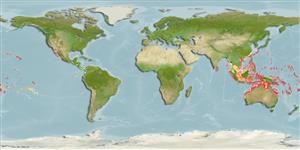>
Eupercaria/misc (Various families in series Eupercaria) >
Scaridae (Parrotfishes) > Scarinae
Etymology: Scarus: Greek, skaros = a fish described by anciente writers as a parrot fish; 1601 (Ref. 45335).
More on author: Bleeker.
Environment: milieu / climate zone / depth range / distribution range
ນິເວດວິທະຍາ
ສັດທະເລ ກ່ຽວກັນຫີນ; ລະດັບຄວາມເລິກ 1 - 50 m (Ref. 37816). Tropical; 30°N - 28°S, 94°E - 124°W
Pacific Ocean: Cocos (Ref. 9399) and Christmas (Ref. 30874) islands in the eastern Indian Ocean; then from Moluccas to the Tuamoto and Austral islands, north to the Ryukyu Islands, south to Shark Bay and the southern Great Barrier Reef and Rapa.
ຂະໜາດ / ນ້ຳໜັກ / Age
Maturity: Lm ? range ? - ? cm
Max length : 40.0 cm TL ຕົວຜູ້/ບໍ່ມີເພດ; (Ref. 9137); 30.0 cm TL (female)
ຄີ (ໜາມ)ແຂງຢູ່ຫຼັງປາ (ທັງໝົດ) : 9; ຄີຫຼັງຂອງປາ (ຄີອ່ອນ) (ທັງໝົດ) : 10; ຄີ(ໜາມ) ແຂງຢູ່ຄີກົ້ນປາ
ກຸ່ມປາກະດູກແຂງ
ຄວາມຖີ່ຂອງກຸ່ມຖ່າຍທອດພັນ
ປາທີ່ມີການເຄື່ອນຍ້າຍຈາກທະເລໄປຫານ້ຳຈືດ ແລະນ້ຳຈືດຫາທະເລ
ປາທີ່ມີການເຄື່ອນຍ້າຍຈາກທະເລແລະໄປໄຂ່ຢູ່ນ້ຳຈືດ
ຄີກົ້ນຂອງປາ
ສັດທີ່ມີກະດູກສັນຫັຼງ
ການຖ່າຍທອດທາງກຳມະພັນຈາກພໍ່ແມ່ຫາລູກ: 3; ຄີກົ້ນຂອງປາ: 9. Scales large. 4 median predorsal scales; 2 scale rows on cheek. Caudal fin slightly rounded in initial phase, retained in terminal males with protruding lobes giving a double emarginate effect. Lips cover or nearly cover dental plates. Initial-phase fish without canines; terminal males usually with 1 upper canine and 2 on lower. The initial phase is characterized by a series of irregular dark chevrons which may be difficult to see on dark individuals (Ref. 1602). The basic color may range from a pale gray to a deep mahogany (Ref. 1602). Large initial phase fish develop the dark greenish markings around the lip found in the terminal phase (Ref. 1602).
Inhabits lagoon and seaward reefs from 1 to over 50 m depth. Adults are common in areas with rich coral and high vertical relief (Ref. 9710, 48636). A solitary species (Ref. 90102). Juveniles may school with other species. Form feeding aggregations on rubble and mixed rubble-coral slopes rather than on flats. Females often in schools of mixed species when feeding, males usually seen separate (Ref. 48636). Feeds on benthic algae (Ref. 89972). Males exhibit territorial tendencies.
Life cycle and mating behavior
Maturities | ການສືບພັນ | Spawnings | Egg(s) | Fecundities | ຕົວອ່ອນ
Oviparous, distinct pairing during breeding (Ref. 205).
Randall, J.E., G.R. Allen and R.C. Steene, 1990. Fishes of the Great Barrier Reef and Coral Sea. University of Hawaii Press, Honolulu, Hawaii. 506 p. (Ref. 2334)
IUCN Red List Status (Ref. 130435)
Threat to humans
Harmless
Human uses
ການປະມົງ: ເປັນສີນຄ້າ; ຕູ້ປາ: ເປັນສີນຄ້າ
ເຄື່ອງມື
Special reports
Download XML
ແຫຼ່ງອີນເຕີເນັດ
Estimates based on models
Preferred temperature (Ref.
123201): 24.5 - 28.8, mean 27.6 °C (based on 432 cells).
Phylogenetic diversity index (Ref.
82804): PD
50 = 0.5000 [Uniqueness, from 0.5 = low to 2.0 = high].
Bayesian length-weight: a=0.01660 (0.01096 - 0.02514), b=3.03 (2.91 - 3.15), in cm total length, based on LWR estimates for this species & Genus-body shape (Ref.
93245).
ຊັ້ນເຂດຮ້ອນ (Ref.
69278): 2.0 ±0.0 se; based on diet studies.
ຄວາມຢືດຢຸ່ນ (Ref.
120179): ຂະໜາດກາງ, ປະຊາກອນຕຳ່ສຸດທີ່ໃຊ້ເວລາສອງເທົ່າ 1.4 - 4.4 ປີ (K=0.22).
Fishing Vulnerability (Ref.
59153): Low to moderate vulnerability (32 of 100).
Nutrients (Ref.
124155): Calcium = 36.2 [23.6, 62.3] mg/100g; Iron = 0.715 [0.503, 1.097] mg/100g; Protein = 18.5 [16.5, 20.3] %; Omega3 = 0.0925 [, ] g/100g; Selenium = 20.5 [12.5, 32.8] μg/100g; VitaminA = 53.7 [16.6, 172.4] μg/100g; Zinc = 2.23 [1.68, 2.88] mg/100g (wet weight);
